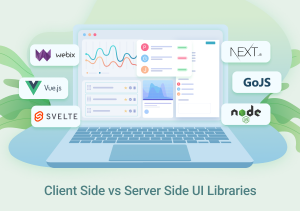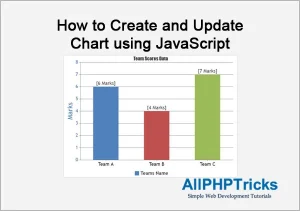Client Side vs Server Side UI Libraries

There are many JS UI libraries available on the market today. They offer developers a wide range of features, prices, and depth of technical support. All of them can be divided into two groups according to the type of UI rendering used: server-side and client-side rendering libraries. In this article, we will discuss the differences between the two approaches to data rendering and provide examples of both types among popular software solutions. The article will be useful for the developers dealing with UI.
There have always been followers of one type of rendering or the other. It’s a matter of the personal developer’s preferences and also the requirements of each particular project. Otherwise, it depends on the kind of application you are creating. Some pages are good for server rendering, while others require client rendering only. One more option is mixed rendering that can be successfully applied sometimes. With mixed types, operations with static pages, such as entering new content, processing and distributing it, are carried out on the server. At the same time, JavaScript for the pages with a high level of interactivity is preloaded on the client side. This is the situation that such projects as Netflix benefit from. However, the architecture with both types of rendering is a separate class of solutions with their peculiarities. We are not going to dwell upon them in this article.
Let’s closer explore the server-side rendering. With this type of rendering, the entire HTML code of the page is generated on the server in response to a request. Thus, the server performs all the work and no additional data requests are required from the user.
Server rendering contains several obvious advantages:
- When we run the page logic and render the data on the server, it prevents the system from sending a large amount of JavaScript to the client. Users receive only text and links, which results in quick page interactivity.
- Server rendering is friendly with a wide range of devices and network conditions. It allows further browser optimizations like document streaming parsing.
The main disadvantage of the server rendering lies in the following argument:
- The formation of a page on the server takes time. The server has to produce a new page for every new interaction with a user. As a result, the loading time can increase and there may appear issues with the app responsiveness.
Now we will provide a couple of server-side UI libraries:
- Go.js
This is a framework for the fast creation of interactive diagrams. The diagrams can be built with JavaScript and Typescript. The framework supports all popular modern frameworks (React, Angular, Vue).
- Node.js
This is an open-source JavaScript solution. It can be successfully used to create real-time web apps, as well as browser games.
- Next.js
Another open-source platform offers a React front-end framework. Pre-rendering a page at request time or build time is possible.
We are moving forward to the client-side type of rendering. The main difference of this approach is that the pages are rendered directly in the browser with the help of JavaScript. All operations and logic, including data gathering, templates application, and routing are managed on the client side.
The advantages of the client-side rendering:
- With so-called lazy loading, you boot only part of the page you need, so the speed of the app increases.
- Animated interaction with the user becomes easier and faster.
Disadvantages of the approach include:
- Difficulties with the speed on mobile devices. This happens because the JavaScript files have to be loaded on the client side, which may take some time. Mobile devices and disruptions of the Internet connection may cause poor performance. However, this issue may be solved with the help of code separation.
- Crawlers will have some difficulties with indexing the page.
Client-side UI libraries:
This is a rich library of JS UI widgets. Complex widgets are turnkey SPAs, that can be effectively combined or used independently. The library guarantees compatibility with all devices, browsers, and popular frameworks.
- Svelte
This project was the leader of the recent Stack Overflow Developer Survey in the category of the most loved frameworks. The approach of the framework lies in effective performance with less code.
- Vue.js
This is a progressive and widely used JS framework for creating web user interfaces. It provides detailed documentation and a wide ecosystem.
Conclusion
We have managed to briefly show the differences between the client-side and server-side rendering. Every project is unique and requires careful preparation stage. Once the type of rendering is decided upon start looking for the most suitable UI framework. We have provided you with the most powerful and robust solutions.
Facebook Official Page: All PHP Tricks
Twitter Official Page: All PHP Tricks



